[Editor’s Note: Mad Scientist Laboratory is pleased to publish this morning’s piece by guest blogger Ms. Sage Miller, addressing the geopolitical implications of climate change, specifically its role as a catalyst for instability. Read on to learn why this matters to the U.S. Army!]
Science dictates that climate change is happening.1 The atmospheric concentration of carbon dioxide, a naturally occurring greenhouse gas, is rising at an alarming rate, allowing less heat to escape into space. The average surface temperature of the Earth is rising, causing glaciers to melt and global sea levels to rise. These changes to water resources, food supply, and regional weather patterns all hold implications for human security and geopolitics.2
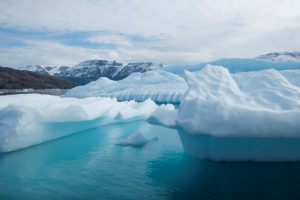 Climate change is most often discussed in terms of its ecological and environmental impacts; rarely is it touched upon as a direct national security threat. The DoD has formally recognized the severity of climate change with references to it as a “threat multiplier.”3 However, climate change not only intensifies other threats, but creates threats in its own right. To ignore environmental factors in tracing the causes of conflicts and other global events would be missing a key piece of the puzzle.
Climate change is most often discussed in terms of its ecological and environmental impacts; rarely is it touched upon as a direct national security threat. The DoD has formally recognized the severity of climate change with references to it as a “threat multiplier.”3 However, climate change not only intensifies other threats, but creates threats in its own right. To ignore environmental factors in tracing the causes of conflicts and other global events would be missing a key piece of the puzzle.
Climate change will have several significant strategic impacts affecting the Army, the DoD, and the future geopolitical landscape.
1. Expanding zones of competition. The melting of the polar ice caps is opening up the Arctic as a new ocean – and thus, a new sphere of competition. Easier access to these waters increases tourism, shipping, resource exploration and extraction, and military activities.4 The wealth of Arctic natural resources promises significant economic gains, as does the potential access to new shipping lanes. Most importantly, the opening of the Arctic connects two important potential theaters of engagement, the Indo-Pacific and Europe, to the homeland.5
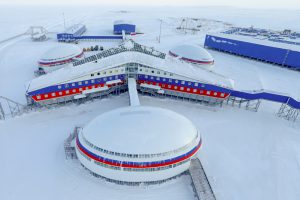 The 2019 DoD Arctic Strategy explicitly expresses our desire to maintain supremacy in the region and counter Russian and Chinese incursions.6 With multiple Arctic nations remaining proactive when it comes to climate change, American inaction will only grant these states the opportunity to insert themselves and gain a foothold, enabling them to climb to regional hegemony. Neglecting this national security issue plays into the hands of our competitors, setting a dangerous precedent.
The 2019 DoD Arctic Strategy explicitly expresses our desire to maintain supremacy in the region and counter Russian and Chinese incursions.6 With multiple Arctic nations remaining proactive when it comes to climate change, American inaction will only grant these states the opportunity to insert themselves and gain a foothold, enabling them to climb to regional hegemony. Neglecting this national security issue plays into the hands of our competitors, setting a dangerous precedent.
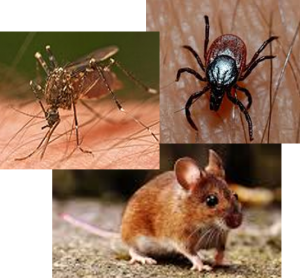 2. The health of our troops is far from guaranteed. A number of infectious diseases, such as malaria, West Nile virus, cholera, and Lyme disease, are expected to worsen as climate change continues to raise global temperatures and cause more extreme weather.7 Higher temperatures and precipitation will increase the life expectancy and range for vectors such as mosquitos, ticks, and rodents.8 Poor global health infrastructure will only amplify the spread of these and other diseases, as increasing global connectivity and changing environmental conditions change the geographic distribution of pathogens and their hosts.9 With a significant number of U.S. troops stationed abroad, the spread of vector-borne diseases is only going to grow more likely.
2. The health of our troops is far from guaranteed. A number of infectious diseases, such as malaria, West Nile virus, cholera, and Lyme disease, are expected to worsen as climate change continues to raise global temperatures and cause more extreme weather.7 Higher temperatures and precipitation will increase the life expectancy and range for vectors such as mosquitos, ticks, and rodents.8 Poor global health infrastructure will only amplify the spread of these and other diseases, as increasing global connectivity and changing environmental conditions change the geographic distribution of pathogens and their hosts.9 With a significant number of U.S. troops stationed abroad, the spread of vector-borne diseases is only going to grow more likely.
Melting permafrost in the Arctic is releasing diseases that we have not encountered in hundreds or even thousands of years.10 Permafrost acts as an excellent preserver of bacteria and viruses due to the lack of oxygen and light, and global warming is slowly exposing older layers of permafrost.11 With climate change accelerating these changing disease vectors, the very security and health of our troops is threatened. 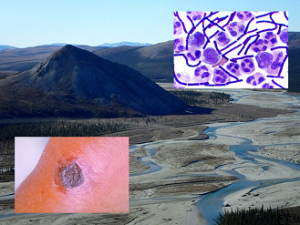 In 2016, thawing permafrost in northern Siberia melted to reveal a reindeer carcass that had been infected with anthrax, leading to dozens of hospitalizations and the death of a 12-year-old boy, as well as over 2,300 reindeer.12 The warming climate, facilitating the release of old diseases and expanding the ranges of disease vectors, portends a deadly future.
In 2016, thawing permafrost in northern Siberia melted to reveal a reindeer carcass that had been infected with anthrax, leading to dozens of hospitalizations and the death of a 12-year-old boy, as well as over 2,300 reindeer.12 The warming climate, facilitating the release of old diseases and expanding the ranges of disease vectors, portends a deadly future.
3. Installations worldwide are increasingly endangered. Melting of the polar ice caps is causing the sea to rise at an alarming rate. These climate-driven changes are causing major harm to U.S. military bases both at home and abroad.13 In 2018 alone, extreme weather events damaged one Marine Corps base and two Air Force bases, and necessitated over $8 billion in repairs.14 Coastal installations are most at risk from flooding, storms, and other shifts in weather patterns. At Norfolk Naval Shipyard in Norfolk, Virginia, sea level rise has caused nine major floods in the last 10 years.15 An analysis conducted by a team of experts from the Union of Concerned Scientists found that eight bases may lose a quarter to half of their land by the end of the century, and that “Four installations –  Naval Air Station Key West, Joint Base Langley-Eustis, Dam Neck Annex, and Parris Island – are at risk of losing between 75 and 95 percent of their land.”16 Damaged installations may compromise material and logistic support, and training could be sacrificed in favor of rebuilding.17
Naval Air Station Key West, Joint Base Langley-Eustis, Dam Neck Annex, and Parris Island – are at risk of losing between 75 and 95 percent of their land.”16 Damaged installations may compromise material and logistic support, and training could be sacrificed in favor of rebuilding.17
In the Indian Ocean, Diego Garcia is home to a joint U.K.-U.S. military base that provides support for “a range of critical war-fighting operations in the region, including as a staging area for special operations forces, submarine support 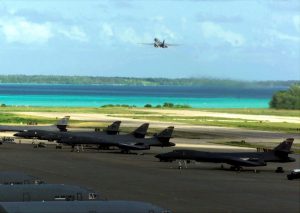 for those special operations, and long-range bomber flights into Afghanistan.”18 Unfortunately, Diego Garcia is a “low-lying atoll whose natural barriers to accelerating sea level rise and storm surge (coral reefs) are being significantly degraded by climate change.”19
for those special operations, and long-range bomber flights into Afghanistan.”18 Unfortunately, Diego Garcia is a “low-lying atoll whose natural barriers to accelerating sea level rise and storm surge (coral reefs) are being significantly degraded by climate change.”19
Installations at risk from climate change-induced threats such as sea-level rise and coastal erosion will impact all aspects of U.S. military strategy. Potential risks range from loss of mission capabilities to increased potential for loss of life.20 The Army’s ability to project forces globally will be challenged as these installations are further degraded due to climate change.
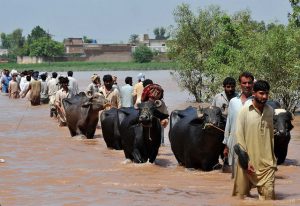 4. Climate change impacts will lead to mass migration. A report by the World Bank found that climate change increases migration through various existing drivers, such as “depressing rural wages, raising agricultural prices, shaping exposure to hazards, and stressing ecosystems.”21 Warming, drought, rising sea levels, natural disasters, and resource scarcity are all drivers of migration caused by climate change. This trend, in combination with steep population growth in many regions, points towards a rising number of climate refugees.
4. Climate change impacts will lead to mass migration. A report by the World Bank found that climate change increases migration through various existing drivers, such as “depressing rural wages, raising agricultural prices, shaping exposure to hazards, and stressing ecosystems.”21 Warming, drought, rising sea levels, natural disasters, and resource scarcity are all drivers of migration caused by climate change. This trend, in combination with steep population growth in many regions, points towards a rising number of climate refugees.
The World Bank’s report focuses on three regions: Sub-Saharan Africa, South Asia, and Latin America. The report projects that by 2050, more than 143 million people across these regions could be forced to move within their own countries to escape the impacts of climate change.22 This massive amount of migration will only further compound resource scarcity and aggravate the potential for civil unrest.
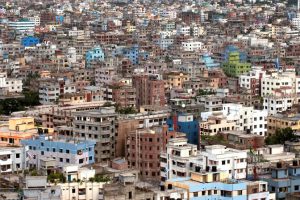 Most importantly, rural to urban migration will only continue to increase as population growth and resource scarcity compel more and more people to seek a better life in cities.23 Urbanization itself has significant military implications. Large masses of disillusioned, economically disadvantaged people vulnerable to disease and unrest will gather in dense urban areas. As more and more people migrate to urban areas, the likelihood that the Army will conduct operations in a dense urban environment increases.
Most importantly, rural to urban migration will only continue to increase as population growth and resource scarcity compel more and more people to seek a better life in cities.23 Urbanization itself has significant military implications. Large masses of disillusioned, economically disadvantaged people vulnerable to disease and unrest will gather in dense urban areas. As more and more people migrate to urban areas, the likelihood that the Army will conduct operations in a dense urban environment increases.
5. Regional instability will only grow. Climate change is inherently global; as such, different regions will be impacted differently. For instance, while the Arctic is melting rapidly, causing sea-level rise and heavy storms in the Asia-Pacific, the Middle East is experiencing extreme drought and desertification.24
As these events increase in intensity and commonality, they could cause mass panic and upheaval. Climate change is already sparking events around the world that lead to violence and conflict, such as:
 a. The Arab Spring. With an event as complex as the Arab Spring, drawing precise causal arrows is virtually impossible. However, vulnerability of the Middle East and North Africa region to various climate-impacted phenomena show that security is directly linked to stability. The failure of governments to meet the basic needs of citizens by responding to climatic issues such as drought, desertification, and food shortages is what drove many to take part in the series of political uprisings.25 With climate change increasingly impacting human security, events such as the Arab Spring will only continue to follow.
a. The Arab Spring. With an event as complex as the Arab Spring, drawing precise causal arrows is virtually impossible. However, vulnerability of the Middle East and North Africa region to various climate-impacted phenomena show that security is directly linked to stability. The failure of governments to meet the basic needs of citizens by responding to climatic issues such as drought, desertification, and food shortages is what drove many to take part in the series of political uprisings.25 With climate change increasingly impacting human security, events such as the Arab Spring will only continue to follow.
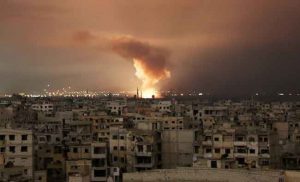 b. The Syrian civil war. Air Force Chief of Staff General David Goldfein told the Senate Armed Services Committee that the brutal civil war raging in Syria is a prime example of the kind of climate change-induced conflicts that the U.S. may have to respond to militarily. A ten-year drought in the region led Syrians to flock to cities unable to adequately meet the demand for resources, leading the Syrians to revolt due to the government’s inability to support them.26
b. The Syrian civil war. Air Force Chief of Staff General David Goldfein told the Senate Armed Services Committee that the brutal civil war raging in Syria is a prime example of the kind of climate change-induced conflicts that the U.S. may have to respond to militarily. A ten-year drought in the region led Syrians to flock to cities unable to adequately meet the demand for resources, leading the Syrians to revolt due to the government’s inability to support them.26
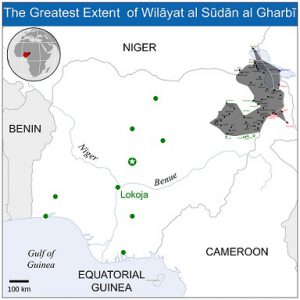 c. Boko Haram. Climate change has been found to be linked to political violence in Nigeria. Poor responses to climate change have increased risks of conflict, such as low economic opportunity and negative relations between the government and its citizens.27 Reports show that chronic drought around Lake Chad, whose water levels have fallen by 95% since the 1960s, has helped Boko Haram maintain its stronghold on the region due to the erosion of trust in the government and the subsequent ease of recruiting extremist soldiers.28
c. Boko Haram. Climate change has been found to be linked to political violence in Nigeria. Poor responses to climate change have increased risks of conflict, such as low economic opportunity and negative relations between the government and its citizens.27 Reports show that chronic drought around Lake Chad, whose water levels have fallen by 95% since the 1960s, has helped Boko Haram maintain its stronghold on the region due to the erosion of trust in the government and the subsequent ease of recruiting extremist soldiers.28
These are only a few of the geopolitical implications that climate change brings. New and existing threats will only grow more pressing and more relevant to the Army. Climate change has and will continue to act as an accelerant for instability, which will threaten not only developing nations, but developed liberal democracies as well. As climate change worsens, the military will soon be most challenged by an enemy it cannot truly fight.
If you enjoyed this post, please read:
– Future Threats: Climate Change and Islamic Terror, by Mr. Matthew Ader
– Emergent Global Trends Impacting on the Future Operational Environment
– Our Arctic—The World’s Pink Flamingo and Black Swan Bird Sanctuary, by Mr. Frank Prautzsch
Ms. Sage Miller is a rising junior participating in the Joint Degree Programme with the College of William & Mary in Virginia and the University of St. Andrews in Scotland, studying International Relations. She is currently interning at Headquarters, US Army Training and Doctrine Command (TRADOC) with the Mad Scientist Initiative.
1 “Climate Change: How Do We Know?” NASA, 20 June 2019, https://climate.nasa.gov/evidence/.
2 “Climate Change Impacts,” National Oceanic and Atmospheric Administration, Department of Commerce, Feb. 2019, www.noaa.gov/education/resource-collections/climate-education-resources/climate-change-impacts.
3 “National Security Implications of Climate-Related Risks and A Changing Climate,” Department of Defense, 23 July 2015, p. 8.
4 Ibid, p. 3.
5 “The Arctic Institute’s Reaction to the 2019 Department of Defense (DoD) Arctic Strategy,” The Arctic Institute, 7 June 2019, https://www.thearcticinstitute.org/the-arctic-institute-reaction-2019-department-defense-dod-arctic-strategy/.
6 “Report to Congress: Department of Defense Arctic Strategy,” Office of the Under Secretary of Defense for Policy, Department of Defense, June 2019.
7 Renee Cho, “How Climate Change Is Exacerbating the Spread of Disease,” State of the Planet, Earth Institute, Columbia University, 4 September 2014, https://blogs.ei.columbia.edu/2014/09/04/how-climate-change-is-exacerbating-the-spread-of-disease/.
8 Ibid.
9 “Trends Transforming the Global Landscape,” Global Trends, Office of the Director of National Intelligence, https://www.dni.gov/index.php/global-trends/trends-transforming-the-global-landscape.
10 Stephanie Pappas, “5 Deadly Diseases Emerging from Global Warming,” LiveScience, 3 August 2016, https://www.livescience.com/55632-deadly-diseases-emerge-from-global-warming.html.
11 Jasmin Fox-Skelly, “There are diseases hidden in the ice, and they are waking up,” BBC Earth, BBC, 4 May 2017, http://www.bbc.com/earth/story/20170504-there-are-diseases-hidden-in-ice-and-they-are-waking-up.
12 Ibid.
13 Caitlin Werrell, et al. “A ‘Responsibility to Prepare’: A Strategy for Presidential Leadership on the Security Risks of Climate Change,” War on the Rocks, 14 June 2019, https://warontherocks.com/2019/06/a-responsibility-to-prepare-a-strategy-for-presidential-leadership-on-the-security-risks-of-climate-change/.
14 Ibid.
15 Nicholas Kusnetz, “Rising seas threaten Norfolk Naval Shipyard, raising fears of ‘catastrophic damage’,” InsideClimate News, NBC, 19 November 2018, https://www.nbcnews.com/news/us-news/rising-seas-threaten-norfolk-naval-shipyard-raising-fears-catastrophic-damage-n937396.
16 Erika Spanger-Siegfried, et al., “The US Military on the Front Lines of Rising Seas,” Union of Concerned Scientists, August 2016, https://www.ucsusa.org/global-warming/science-and-impacts/impacts/sea-level-rise-flooding-us-military-bases.
17 Nicole Gauette, et al., “Hearing on climate change and national security becomes an angry partisan clash,” CNN, 9 April 2019, https://edition.cnn.com/2019/04/09/politics/house-climate-natsec-hearing/index.html.
18 Gen. Ronald Keys, et al., “Military Expert Panel Report: Sea Level Rise and the U.S. Military’s Mission,” The Center for Climate and Security, September 2016, p. 21.
19 Ibid.
20 Ibid, p. 6.
21Kanta Kumari Rigaud, et al., “Groundswell: Preparing for Internal Climate Migration,” World Bank, 19 March 2018, p. 23
22 Ibid.
23“Cities on the Frontline,” Children’s Investment Fund Foundation, Accessed: 25 June 2019, https://ciff.org/impact/cities-frontline/.
24 “The National Security Implications of Climate Change,” Environmental and Energy Study Institute, 5 June 2017, https://www.eesi.org/briefings/view/060517security.
25 Werrell, Caitlin E., and Francesco Femia, eds. The Arab Spring and climate change: a climate and security correlations series. Center for American Progress, 2013, p. 3, https://www.americanprogress.org/issues/security/reports/2013/02/28/54579/the-arab-spring-and-climate-change/.
26 Nicole Gauette, et al., “Hearing on climate change and national security becomes an angry partisan clash,” CNN, 9 April 2019, https://www.edition.cnn.com/2019/04/09/politics/house-climate-natsec-hearing/index.html.
27 Tom Sarsfield, “How Climate Change Affects African Security,” War Room, United States Army War College, 13 June 2019, https://warroom.armywarcollege.edu/articles/climate-change-african-security/.
28 Megan Darby. “Boko Haram Terrorists Thriving on Climate Crisis: Report,” Climate Home News, Climate Home, 19 April 2017, www.climatechangenews.com/2017/04/20/boko-haram-terrorists-thriving-climate-crisis-report/.

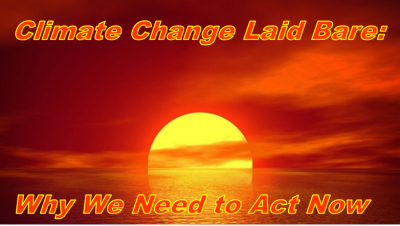


The real national security issues are education and tribalism. When a large number of people selectively deny science after not being properly trained and educated on science, then their science denial is reinforced by tribalism, you get a lack of action by both the population and its elected government. Thus problems grow and rather than requiring a pound of cure, that deliberately refused ounce of prevention will now require much tonnage of cure, impacting across the elements of national power, in ways we can clearly foresee now and those which we cannot. The DoD must take the lead in advancing the national security issues deriving from climate change, both those mentioned by the author and many more.
The following comment was received from Mad Scientist Laboratory guest blogger Dr. Juan A. Vitali:
“Good overview of the problem. How can we offer some solutions? What are possible answers to mitigate or stop global warming altogether?
Here is one thought:
The heretofore reliance on the internal combustion engine has been the key “pollutant multiplier” causing climate change.
We need to move aggressively toward the electrification of the DoD fleet. Europe is leading, We need to follow.
How can TRADOC be a catalyst for this type of change?”
Comments concerning point 1:
“The 2019 DoD Arctic Strategy explicitly expresses our desire to maintain supremacy in the region and counter Russian and Chinese incursions.” I argue that the U.S. is not currently the dominant player in the Arctic. It is in fact a reluctant Arctic nation. The Russians have outclassed us in the land, air, and maritime domains of the region for years. The U.S. has no military bases above the Arctic Circle, and a pitiful one ice breaker. China’s entrance into the region have been primarily in the economic realm. Chinese investment in Greenland’s economy is 12% of its gross domestic product and about 6% of Iceland’s GDP. China has bid on a new Greenland airport which has an estimated cost of 3.6 billion Danish krone ($560 million). Such a massive infrastructure project for whatever company wins could potentially set China up as a major economic driver for Greenland. Additionally, Chinese businesses control 10% of Europe’s cargo hubs. Through the “Data Silk Road”, it is laying undersea cable to move financial data more quickly from point-to-point. China has invested $90 billion in a host of projects above 60 degrees north with likely more to follow, if oil prices rise.
Good question. All problem set analyses will result in a set of root causes for why things are happening. Set can include one or multiple causes. Multiple root causes can be ranked by most impactful to least. Taking action to address the top one or few most impactful root causes has the most impact on the problem. I’m not currently aware of the top three major causes of anthropogenic climate change but concur that fossil fuels writ large are a main if not the main contributor. Recommend scientific consensus on the top three root causes then TRADOC action to inform DA and DoD. Recommend incorporating the US Army Corps of Engineers and the DoD S&T community in this analysis as well as the ‘traditional’ climate scientists. Analysis must include recommended solution COAs. Then recommend working up the chain, gaining concurrence on the analysis and the recommended solutions and identifying where the chain of concurrence breaks down due to science denial or political tribalism, and working to address those issues. Definitely recommend taking also this to the appropriate desks in Congress for funding. Bottom line is this is truly a current and significant national security issue, not a cabal of left wing Luddite scientists having an academic discussion on a far-future issue. Leaders with rank need to take ownership of this issue and serve as champions, else the issue will be shelved until the halls of Congress are ankle deep in seawater and the reality can be denied no longer.
Good Article, needs a follow up to address additional set of impacts to include the following: 1) Increased demand placed on US Army Corps of Engineers and US Army National Guard units to provide defense support for civilian authorities here in US in response to more extreme weather events; 2) Training restrictions brought on by heat (no strenuous outside activity in CAT BLACK days) and increased chance of range fires from drought and heat; 3) Further refinement of point #5 in that the issue here is governance capacity – climate change will increase demands on governments to provide basic services, security etc. Weak states will not be able to meet the increased demands, leading to decline and collapse, this in turn creates security challenges.